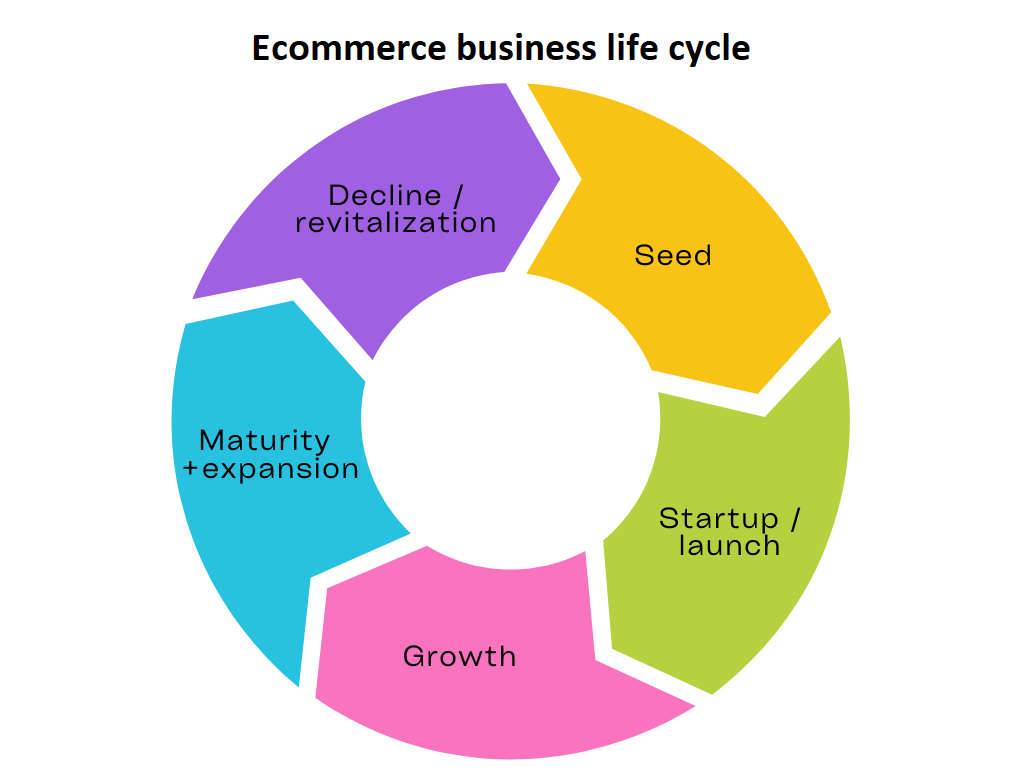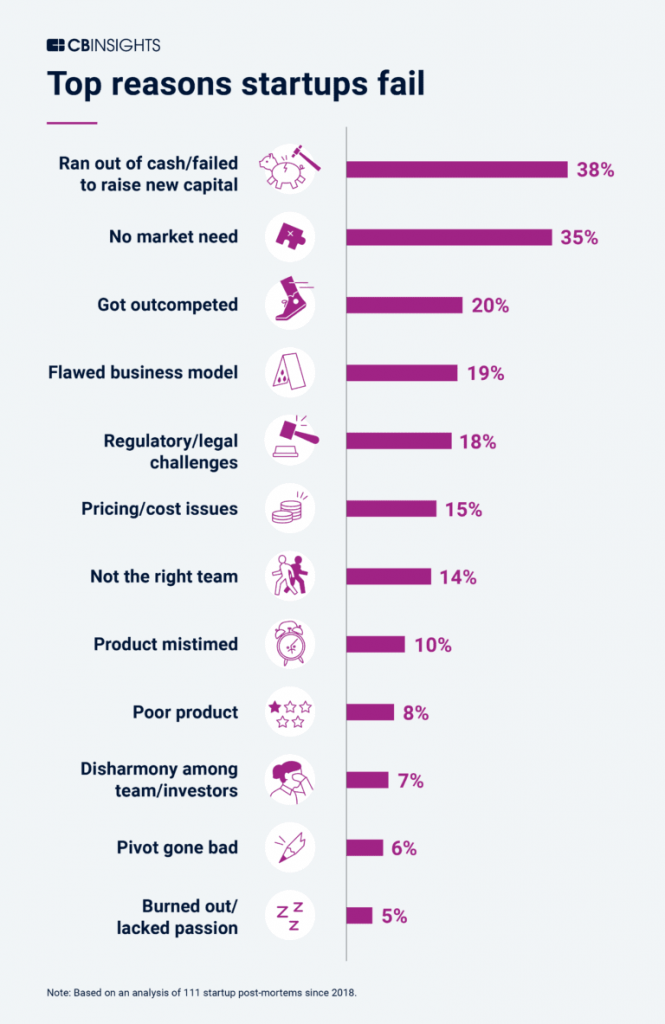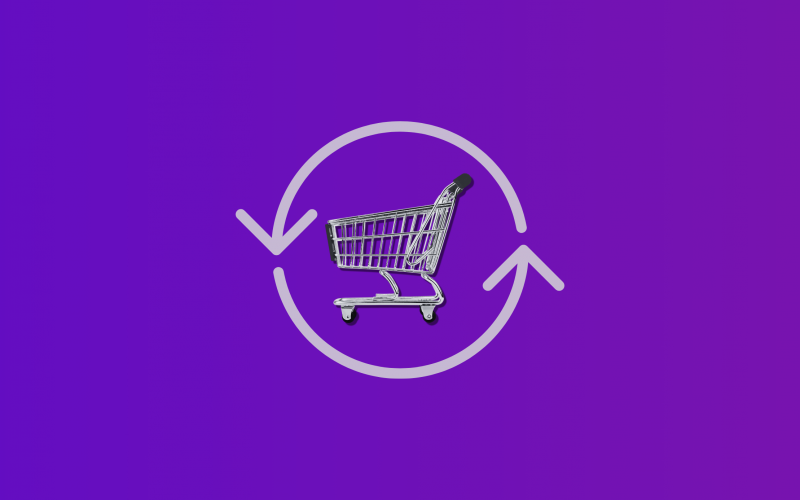Ecommerce has reinvented the way we do shopping and business. To survive and thrive, an ecommerce company should successfully navigate the stages of the business life cycle, address their challenges and seize opportunities, bearing in mind that those opportunities often come in the disguise of hard work.
Getting closer to the stages of the life cycle of an ecommerce business, it should be mentioned that they are similar to those of any other business. However, the challenges that a business comes across in each of these stages are peculiar and worth exploring. What are the specific needs and demands of an ecommerce business along its life cycle? All that can shed some light on why this seemingly “easy and profitable” business is not what it might seem at first.
Let’s have a look at the typical stages of an ecommerce business life cycle.

1. Seed
Seed stage includes the following steps:
Idea Generation
This is the initial point of the ecommerce business, where the founders come up with a unique business idea that they believe can be successful.
Market Research
The business conducts market research to determine the feasibility of the idea and assess the potential market size and competition.
Product Development
Once the market research is completed, the ecommerce business begins developing its product or service, including website design, product sourcing, and logistics.
The challenges of the Seed stage for an ecommerce business might be the following:
Developing a unique value proposition and differentiating yourself from your competition requires a lot of effort. Ecommerce startups need to offer something unique that will attract customers and keep them coming back. And by unique we don’t just mean the quality of a product, but also outstanding order service, return and customer support processes. All that is a part of a unique value proposition. On the whole, there should be a “hook” that you can’t resist swallowing, and it’ll help drive customer satisfaction and bring more orders. 35% of the startups that didn’t survive competition believe that there was no market need for their product. A different survey of 80+ failed startups states 56% of those consider lack of product-market fit the biggest killer.
Finding the right niche and focusing on one product category, limited market segment or location is crucial. Diverse product categories might waste money and effort needed to launch a business. Getting into the unsaturated niche can be crucial for the future of the business. Not doing enough market research and “diving too fast” is named the top reason for startup failure by Professor Thomas R. Eisenmann (the Howard H. Stevenson Professor of Business Administration at the Harvard Business School, Peter O. Crisp Chair, Harvard Innovation Labs, and Faculty Co-Chair of the HBS Rock Center for Entrepreneurship).
Securing funding can’t be underestimated, as ecommerce startups require some capital to get off the ground. The sources of the money are various: personal investment, venture capital, loans and subsidies, crowdfunding, business accelerators or money coming from business angels. Except for personal investment, a business should be able to show a long-term commitment to be able to get the money. One has to bear in mind that at the seed stage, it can be quite difficult to make funding appealing to investors who may hesitate to invest in a new business.
Building a team of talented individuals who can help the business grow and succeed can be a challenge. However, at the seed stage, it may be challenging to attract top talent when the business is still in its early stages. 14% of businesses attribute their failure to “not the right team”.
Dealing with legal issues can be a hurdle on the way, as ecommerce businesses are subject to a variety of laws and regulations, such as data privacy laws and sales tax regulations. At the seed stage, it can be challenging to navigate these complex legal and regulatory issues. 18% of failed startups believe that the reason for their failure were regulatory/legal challenges.
2. Startup or launch
This is the stage where the startup launches its website and begins marketing its products or services to potential customers. Startup stage lasts about 2 years during which, as we remember, 31% of businesses fail. What brings roughly 1/3 of business to an end? As we see it, there are many problematic moments for an ecommerce startup.
Building a customer base is one of the biggest challenges for any ecommerce startup. The startup may not have a lot of resources to spend on marketing and advertising, making it difficult to reach and retain potential customers.
Managing inventory and logistics is also important, because ecommerce startups need to have a solid plan for managing inventory and fulfilling orders. At its initial stages, the startup may not have the resources and experience to manage these processes efficiently, which can lead to delays and dissatisfied customers.
One of the problems an ecommerce startup can face is also poor user experience. This can include slow loading times, difficult navigation, and complicated checkout processes. If customers have a negative experience with the website, they are unlikely to return.
Speaking about the financials, cash flow problems can arise in the early stages of the business. The startup may not be generating enough revenue to cover expenses, making it difficult to invest in growth. 38% of failed startups attribute their failure to problems with cash flow.
Startups may also face significant competition from established players in the industry, as ecommerce is highly competitive. 20% of unsuccessful startups believe they got outcompeted. Once the ecommerce startup moves beyond initial set-up and into growth phases, evolving marketing strategies become critical. It’s important to focus on enhancing online store marketing strategies which are well-explained in a comprehensive guide that delves into identifying and targeting the right markets efficiently

3. Growth
If a company survives the first two years, it’s safe to say that it enters a period of growth, which might be less rocky than the previous one. However, it’s far from resting on laurels. According to the U.S. Bureau of Labor statistics report, only 48.4% of businesses reach the threshold of 5 years. If the first two years of operating take down 31.4% of startups, the next three years add 17% to the list of failed businesses.
When a business reaches its growth stage, it focuses on increasing its customer base, expanding its product offerings, and improving its marketing strategy to increase sales. That’s a very generalized assumption. Getting a bit deeper into it, makes us discover that the growth stage can be divided into substages. According to the Forbes article “The three stages of ecommerce growth” by Mike Bugembe, the ecommerce growth cycle consists of the following three stages:
1) Start-up growth
2) Stagnant growth
3) Scale-up growth
Start-up growth period is characterized by high growth rates resulting from the market’s demand or the product’s popularity. Gaining traction and growing the customer base are the main points of focus at this stage. By this time, the business is likely to have chosen a platform or platforms to function. Quite soon this carefree period of high growth comes to an end and changes into stagnant growth.
Stagnant growth period seems to be crucial and the most disheartening, especially after the period of high growth. Many ecommerce businesses experience pressure because of growing competition and the fear of losing their market share to rivals.
The possible reasons for stagnation can vary from problems with conversion rates, the development team, advertising, even the platform the business chose, but the only reliable solution here is to utilize the data which might provide some useful business insights and help to draw an appropriate roadmap for addressing the challenges. Whether singling out a person who is going to take charge of the data analysis or outsourcing it to an agency, the key moment is to find a reliable way of extracting valuable business insights and unlocking the hidden opportunities for growth.
Scale-up growth follows the period of stagnation and is characterized by getting back on track of stable growth. Analyzing the data properly helps to work out a structured development strategy and find the best optimization opportunities. The key feature of ecommerce companies at this stage is focusing on KPIs and utilizing them to further drive their business, managing the growing team and making sure that new additions to the team are bringing value, and testing all possible variations and changes (site, product representation, advertising etc.) to find those that have the most significant influence on the KPIs.
Summing that up, using reliable business insights at the stage of growth can prove to be not only the vitamin catalyzing your company’s growth, but even the painkiller helping to survive through various challenges on the way.
4. Maturity
Maturity stage manifests itself through a solid market share of the company, its stable and controlled growth and sometimes ideas about expansion to new markets.
Below are the most typical challenges for an ecommerce company at this stage.
Competition never gives you a break, as the market is changing, consumer preferences are shifting and new rivals are coming on stage. To be at the top of the game, one has to constantly monitor their competitors.
Adjusting to the rapidly changing economic situation can help you keep your competitive advantage.
Maintaining customer loyalty never hurts the business, especially with tough competition in ecommerce and the high costs of acquiring new customers.
Supply chain management can become more challenging with numerous orders and customers. The focus of ecommerce companies must be making sure that their suppliers are reliable and can meet the demand for their products, inventory levels and shipping logistics.
Expansion problems may arise if a company decides to expand to new markets. There’s a lot to take into consideration like adjusting product offering, pricing strategies, moving to new platforms, hiring more staff, managing logistics and inventory and what not.
In general, ecommerce companies at the maturity stage must be ready to adjust their business processes and evolve to maintain their competitive edge, which is hardly possible without perpetual data analysis.
5. Decline or revitalization
Let’s make this final stage look a bit more positive by making it a choice between decline and revitalization instead of decline and exit. However, one shouldn’t forget that even after 5 years of functioning and losing almost half of the pool, the rate of failure of new businesses is about 2-4% every year, which means the later stages are much safer.
The most typical reasons for decline might be market saturation, competition, inadequate marketing, economic downturns or other factors. The second option for a company is to rise like a phoenix from ashes and revive its business model by exploring new markets, diversifying its product offerings, or introducing new marketing strategies, which all might remind the seed and startup stages again with more business experience and expertise under the belt. And this is why the term “cycle” is absolutely relevant here.
Wrapping up
While visualizing the ecommerce life cycle might help understand the main pitfalls and opportunities of its stages, analyzing data and using business insights it unlocks can help navigate the turbulent waters of ecommerce safely. Continuous innovation, ability to adapt to changing market conditions and providing value to customers are the pillars of success.
The next piece in this series will be devoted to consumer behavior and marketing trends in ecommerce.
Check out part 1 “Analyzing Ecommerce & Its Popularity: Ecommerce at a Glance”.







.png)

Great article! Thanks for explaining the Ecommerce business life cycle.
Great Post!!
Thank you so much for your feedback, John!